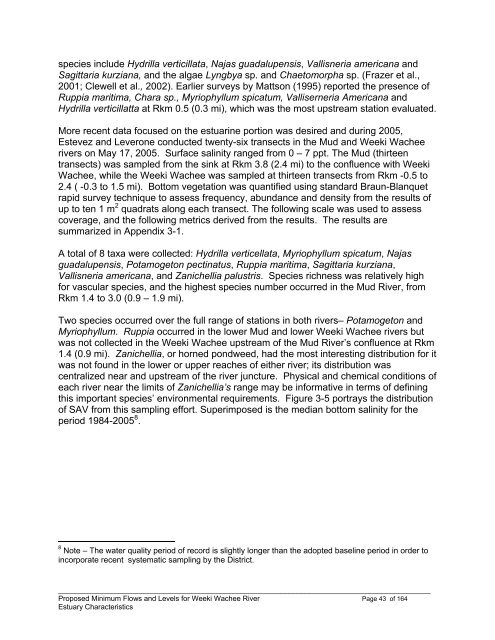Weeki Wachee River System Recommended Minimum Flows and ...
Weeki Wachee River System Recommended Minimum Flows and ...
Weeki Wachee River System Recommended Minimum Flows and ...
You also want an ePaper? Increase the reach of your titles
YUMPU automatically turns print PDFs into web optimized ePapers that Google loves.
species include Hydrilla verticillata, Najas guadalupensis, Vallisneria americana <strong>and</strong><br />
Sagittaria kurziana, <strong>and</strong> the algae Lyngbya sp. <strong>and</strong> Chaetomorpha sp. (Frazer et al.,<br />
2001; Clewell et al., 2002). Earlier surveys by Mattson (1995) reported the presence of<br />
Ruppia maritima, Chara sp., Myriophyllum spicatum, Valliserneria Americana <strong>and</strong><br />
Hydrilla verticillatta at Rkm 0.5 (0.3 mi), which was the most upstream station evaluated.<br />
More recent data focused on the estuarine portion was desired <strong>and</strong> during 2005,<br />
Estevez <strong>and</strong> Leverone conducted twenty-six transects in the Mud <strong>and</strong> <strong>Weeki</strong> <strong>Wachee</strong><br />
rivers on May 17, 2005. Surface salinity ranged from 0 – 7 ppt. The Mud (thirteen<br />
transects) was sampled from the sink at Rkm 3.8 (2.4 mi) to the confluence with <strong>Weeki</strong><br />
<strong>Wachee</strong>, while the <strong>Weeki</strong> <strong>Wachee</strong> was sampled at thirteen transects from Rkm -0.5 to<br />
2.4 ( -0.3 to 1.5 mi). Bottom vegetation was quantified using st<strong>and</strong>ard Braun-Blanquet<br />
rapid survey technique to assess frequency, abundance <strong>and</strong> density from the results of<br />
up to ten 1 m 2 quadrats along each transect. The following scale was used to assess<br />
coverage, <strong>and</strong> the following metrics derived from the results. The results are<br />
summarized in Appendix 3-1.<br />
A total of 8 taxa were collected: Hydrilla verticellata, Myriophyllum spicatum, Najas<br />
guadalupensis, Potamogeton pectinatus, Ruppia maritima, Sagittaria kurziana,<br />
Vallisneria americana, <strong>and</strong> Zanichellia palustris. Species richness was relatively high<br />
for vascular species, <strong>and</strong> the highest species number occurred in the Mud <strong>River</strong>, from<br />
Rkm 1.4 to 3.0 (0.9 – 1.9 mi).<br />
Two species occurred over the full range of stations in both rivers– Potamogeton <strong>and</strong><br />
Myriophyllum. Ruppia occurred in the lower Mud <strong>and</strong> lower <strong>Weeki</strong> <strong>Wachee</strong> rivers but<br />
was not collected in the <strong>Weeki</strong> <strong>Wachee</strong> upstream of the Mud <strong>River</strong>’s confluence at Rkm<br />
1.4 (0.9 mi). Zanichellia, or horned pondweed, had the most interesting distribution for it<br />
was not found in the lower or upper reaches of either river; its distribution was<br />
centralized near <strong>and</strong> upstream of the river juncture. Physical <strong>and</strong> chemical conditions of<br />
each river near the limits of Zanichellia’s range may be informative in terms of defining<br />
this important species’ environmental requirements. Figure 3-5 portrays the distribution<br />
of SAV from this sampling effort. Superimposed is the median bottom salinity for the<br />
period 1984-2005 8 .<br />
8 Note – The water quality period of record is slightly longer than the adopted baseline period in order to<br />
incorporate recent systematic sampling by the District.<br />
____________________________________________________________________________________________<br />
Proposed <strong>Minimum</strong> <strong>Flows</strong> <strong>and</strong> Levels for <strong>Weeki</strong> <strong>Wachee</strong> <strong>River</strong> Page 43 of 164<br />
Estuary Characteristics
















